Now let’s consider the adaptations of modern camels to a life in the harsh extremes of the desert. The most obvious adaptations are the humps, large fat deposits, which the camel can withdraw water from when food and drink are scarce. When they do find it, camels are capable of drinking water very quickly, with some sources indicating as many as thirty gallons in thirteen minutes! Their thick lips allow the animal to go after any vegetation it comes across, including hardy desert plants that are equipped with all sorts of large spikes and thorns. Thick, luscious eyelashes help to block the blowing sand from their eyes, and they can seal off their nostrils to prevent sand from getting in their, as well.* Their feet are broad, equipped with fleshy footpads that help distribute the weight of the camel over a broader surface area, just like a snowshoe.
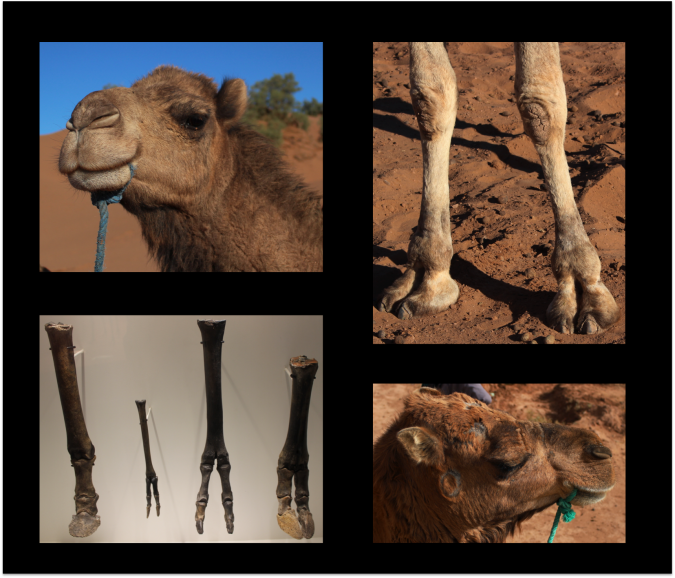
A number of camel adaptations. On the top left and bottom right, check out the luscious eyelashes and the thick lips. On the bottom left, we have a comparison of four different species of ungulate. From left to right, we have a horse (Equus sp.), a white-tailed deer (Odocoileus virginianus), an extinct camel (Paleolama), and an extinct bison (Bison antiquus). Compare the skinny camel foot bones with the enormous, spreading foot in the picture on the top right. Large, fleshy pads allow the camel to distribute its weight over a larger surface area.
While doing research for this blog post, I stumbled across two words that quickly caused this simple post on camels to spiral into a three part extravaganza: “rete mirabile.” Rete mirabile is Latin for “wonderful net,” and refers to a network of veins and arteries that are in close contact to one another. The close proximity of the different blood vessels allows heat to transfer from one to the other, in a process known as countercurrent heat exchange.
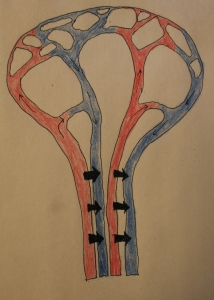
A diagram of a rete mirabile, explained in the paragraph below.
What’s the point of the rete mirabile, or countercurrent heat exchange? A number of warm-blooded animals have some sort of “wonderful net” at work in their bodies, and it aids in thermoregulation. I first came across the term a few years ago while reading Daniel Ksepka’s blog on fossil penguins. Most penguins swim in waters that are colder than their body temperature, and since penguins are birds and birds are warm-blooded, that can be a problem. The large surface area and the low volume of the flipper means that it’ll lose heat to the environment fairly rapidly, faster than the rest of the body. As warm, oxygenated blood is pumped out of the heart and into the wing, the blood immediately begins to cool. The blood, now cold, is then pumped back into the body of the penguin. To help keep the flippers warm, the hot, outgoing blood vessels are in close proximity to the colder, incoming blood vessels. As the blood passes through, some of the heat from the outgoing blood is transferred to the colder blood returning from the flipper to the body of the bird. This ensures that the overall temperature of the flipper doesn’t drop too low, and means that the blood returning to the heart is warmed slightly. The flipper can remain colder, while the core body temperature of the penguin can remain stable.**
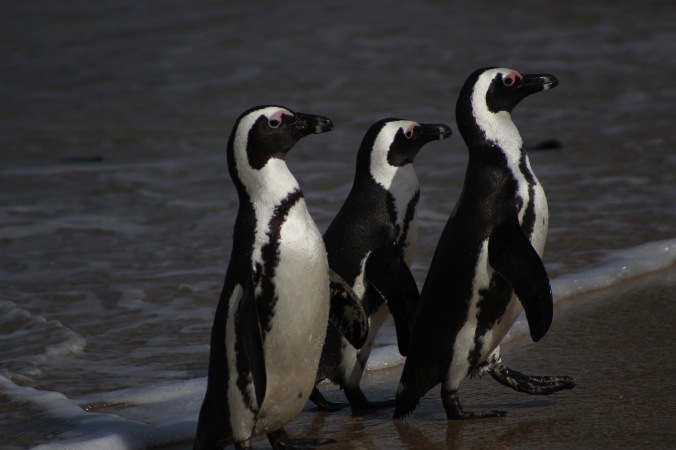
A trio of African penguins (Spheniscus demersus) at Simon’s Town near Cape Town, South Africa. Hidden within their flippers are rete mirabile, that help keep their core temperature warm.
Turns out, the rete mirabile is a pretty common occurrence, and it seems to crop up all over the place, especially in diving and burrowing mammals, both of which tend to suffer from a lack of oxygen. Some studies suggest that allowing the temperature of the limbs to cool means that they need less oxygen anyways, which is of further benefit for these divers and burrowers. Seals and sea lions have them in their flippers, and they can be found in the tails of whales, as well. In 2015, it was discovered that the opah, a large species of sunfish, employ the use of rete mirabile in their gills to help keep their heart warmer than the surrounding water temperature. Arboreal animals, or animals that live in trees, are sometimes found with these wonderful nets, as well, where they are called “vascular bundles.” Some scientists believe that the presence of these bundles is to reduce oxygen consumption in clinging animals, like sloths, pottos, the slow loris, and tree anteaters. They suggest that, since these clinging animals are flexing their muscles (which can restrict bloodflow), the lowered limb temperatures means that less blood flow is required altogether (O’Dea, 1989). Another fascinating example of a mammalian rete mirabile is in the neck of the giraffe. To prevent the blood vessels in the head of a giraffe from bursting when the animal lowers its head below its heart to drink, the blood vessels in the rete mirabile expand, decreasing the pressure of the blood entering the brain!
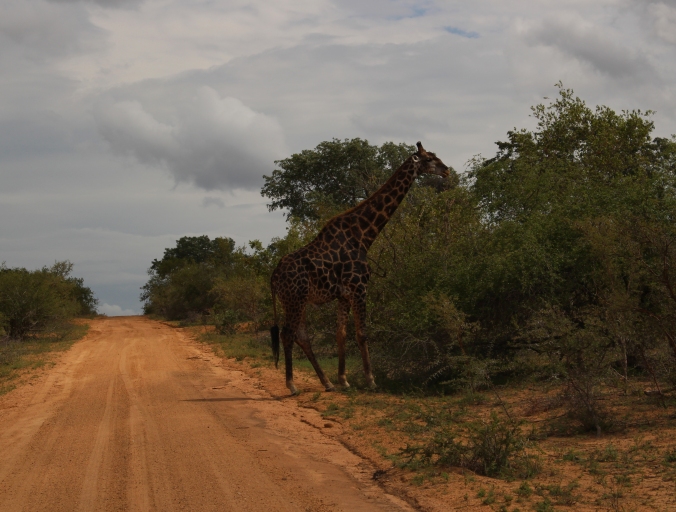
A giraffe (Giraffa camelopardalis) in Kruger National Park, South Africa. To help keep the bloodvessels in the head from bursting when the animal bends down to drink, the giraffe has a rete mirabile in its neck that expand to accommodate the extra blood.
In my research on camels, I was initially surprised to discover that they possess a rete mirabile in their heads. My experience thus far had usually found rete mirabile associated with warm-blooded animals that needed to warm up, but never with warm-blooded animals that needed to cool down! Of course, the temperature of the blood in the blood vessels of the rete mirabile is all relative. In the cold waters off the shores of South Africa, the blood of the African penguin will of course be warmer than its surroundings. But in the scorching heat of the Sahara Desert, the blood of the camel might actually be cooler than the surrounding air temperature! Studies indicate that the rete mirabile in the heads of camels might serve to help decrease the temperature of the brain, allowing it to function in the deadly heat of the desert. More research suggests that a number of birds and mammals actually have some sort of rete mirabile in their heads to help cool the brain, including a number of large migratory seabirds, such as boobys and albatross in the Hawaiian Islands and Midway Atoll (watch for them in an upcoming blog post!).
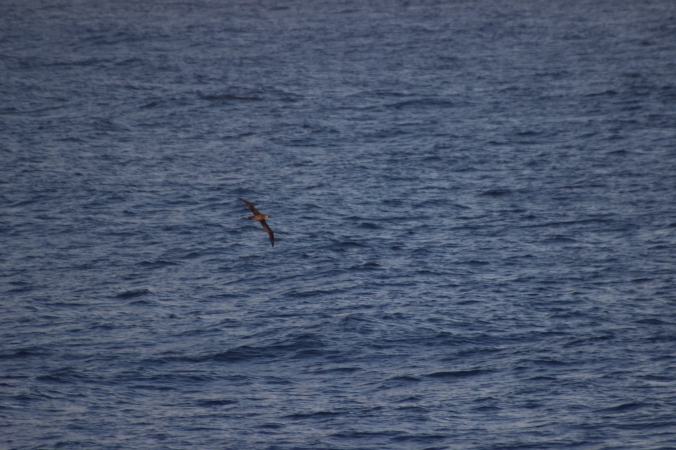
A black-footed albatross (Phoebastria nigripes) soars over the waves in the Pacific Ocean, between Mexico and Hawaii. Like camels, as well as many other seabirds, albatross possess a rete mirabile in their head to help cool their brain.
*After spending just one night in the Sahara Desert, I can confirm Anakin Skywalker’s gripe about sand getting everywhere. It really does. Even after several showers, I was still picking sand out of my hair, ears, and nose for about a week. Even a month and a half later, I still have some sand stuck in my iPhone case.
**This counter-current heat exchange can be used in industry and man-made machines, as well. For example, aircraft sometimes will use heat generated in one part of the machine to heat cold fuel.